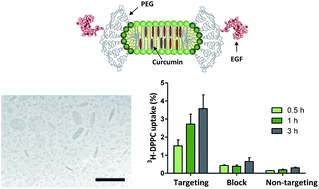EGF-targeting lipodisks for specific delivery of poorly water-soluble anticancer agents to tumour cells†
Abstract
Concerns regarding poor aqueous solubility, high toxicity and lack of specificity impede the translation of many hydrophobic anticancer agents into safe and effective anticancer drugs. The application of colloidal drug delivery systems, and in particular the use of lipid-based nanocarriers, has been identified as a promising means to overcome these issues. PEG-stabilized lipid nanodisks (lipodisks) have lately emerged as a novel type of biocompatible, nontoxic and adaptable drug nanocarrier. In this study we have explored the potential of lipodisks as a platform for formulation and tumour targeted delivery of hydrophobic anticancer agents. Using curcumin as a model compound, we show that lipodisks can be loaded with substantial amounts of hydrophobic drugs (curcumin/lipid molar ratio 0.15). We demonstrate moreover that by deliberate choice of preparation protocols the lipodisks can be provided with relevant amounts of targeting proteins, such as epidermal growth factor (EGF). Data from in vitro cell studies verify that such EGF-decorated curcumin-loaded lipodisks are capable of EGF-receptor specific targeting of human A-431 tumour cells, and strongly suggest that the interaction between the lipodisks and the tumour cells results in receptor-mediated internalization of the disks and their cargo.



 Please wait while we load your content...
Please wait while we load your content...